Cantilever Dental Bridge
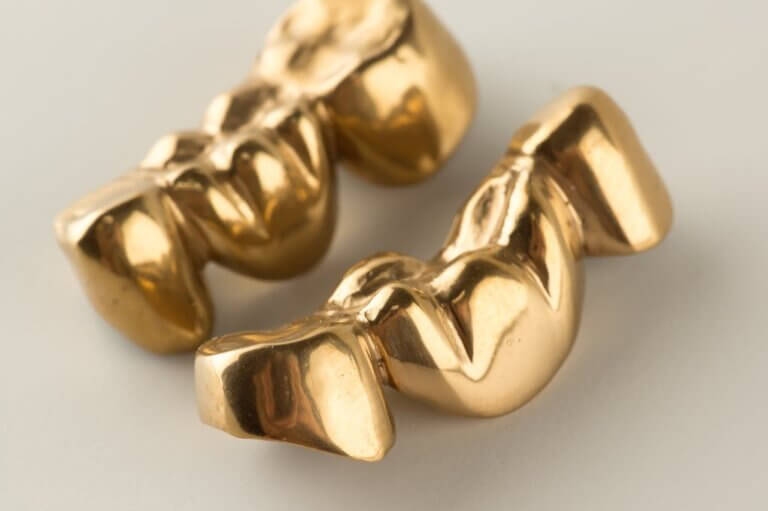
What Is A Gold Dental Bridge?
If you’re missing one or more teeth, a dental bridge could be the solution to restore both the appearance and function of your teeth. Among the various types of dental bridges available, a Gold Dental Bridge stands as a popular choice for its durability, strength, and biocompatibility with oral tissues. The unique feature of a gold dental bridge is that it is made from a gold alloy, which is a combination of gold and other metals like silver, copper, and palladium. Gold has been utilized in dentistry for centuries due to its unique properties, and it continues to hold a special place in certain dental applications. The allure of gold dental bridges extends beyond the functional aspects, encompassing a blend of tradition, durability, and distinctive aesthetics.
Before deciding on whether A Gold Dental Bridge are right for you, there are some things you should know:
- Who Needs A Gold Dental Bridge?
- What Are The Advantages Of A Gold Dental Bridge?
- What Are The Alternative Treatments If I Do Not Choose A Gold Dental Bridge?
- How Much Does A Gold Dental Bridge Cost?
- What Are The Steps In The Gold Dental Bridge Procedure?
- Can I Have A Gold Dental Bridge If I Am Pregnant?
- How Long Does A Gold Dental Bridge Last?
- What Are Common Problems with A Gold Dental Bridge?
If you have any further questions about A Gold Dental Bridge or other dental services offered at Atlas Dental, please contact us.

Free phone consultation
Are you missing teeth and have questions about Dental Bridges? Schedule a free phone consultation with our GTA dentist.

5 star google reviews
Our patients love us! See why people are choosing Atlas Dental for Dental Bridges.

Book Emergency Bridge visit online
Have a problem with your Dental Bridge? Book An Emergency Dental Appointment Online.
Who Needs A Gold Dental Bridge?
A Gold dental bridge can be a suitable solution for individuals who are facing the challenges posed by a missing tooth and are seeking an effective way to restore both the functionality and appearance of their smile. If you find yourself in any of the following situations, a gold bridge might be the right option for you:
- Individuals with Missing Teeth: If you’ve lost one or more teeth, a gold dental bridge can help fill the gaps, preventing adjacent teeth from shifting into the open space and maintaining proper alignment.
- Unsuitable Candidates for Dental Implants: Dental implants are a popular choice for tooth replacement, but not everyone is an ideal candidate due to factors like bone density or health conditions. In such cases, a gold dental bridge can provide a durable alternative for restoring your smile.
- Preservation of Tooth Structure: Unlike removable dentures, dental bridges are fixed prosthetics that do not need to be removed for cleaning. This makes them a suitable choice for individuals who want to preserve their natural tooth structure and avoid the discomfort or inconvenience of removable appliances.
- Maintaining Facial Structure: Tooth loss can lead to a sunken appearance and changes in facial structure over time. By replacing missing teeth with a gold dental bridge, you can help maintain the shape and structure of your face, contributing to a more youthful appearance.
- Enhancing Aesthetics: Some individuals opt for gold dental bridges due to the unique aesthetic appeal of gold alloys. These bridges can have a distinctive color and shine that appeals to those who prioritize the visual aspect of dental restorations.
Ultimately, the decision to opt for a gold dental bridge depends on various factors, including your oral health, preferences, and the recommendations of your dentist. Consulting with a dental professional will help you determine whether a gold dental bridge is the right choice for your specific circumstances. If you have further questions about Gold Dental Bridges, please contact us.
What Are The Advantages Of A Gold Dental Bridge?
A Gold dental bridge has several advantages that contribute to its widespread use:
- Durability: Gold is known for its exceptional durability and resistance to corrosion. Gold dental bridges can withstand the forces of chewing and biting over an extended period, making them a long-lasting option for tooth replacement.
- Biocompatibility: Gold is a biocompatible material, meaning it is well-tolerated by the human body. This reduces the risk of allergic reactions or adverse responses, making gold dental bridges suitable for a wide range of patients.
- Minimal Tooth Modification: To accommodate a gold dental bridge, the adjacent teeth need to be prepared by removing a small portion of their enamel to fit the dental crowns. This minimal modification helps preserve more of your natural tooth structure compared to other restorative options.
- Unique Aesthetics: The distinct color and shine of gold alloys can be visually appealing to some individuals. Gold dental bridges can add a touch of elegance and uniqueness to your smile, especially if you appreciate the aesthetic value of precious metals.
- Strength and Load Distribution: Gold’s strength and malleability allow for the creation of dental bridges that distribute bite forces evenly, reducing the strain on individual teeth and preventing excessive wear.
- Comfort: Once a gold dental bridge is properly fitted, it provides a comfortable and stable solution for chewing, speaking, and smiling. Its fixed nature eliminates the need for removal or adjustments that are often associated with removable dentures.
- Longevity: Due to gold’s resilience and resistance to wear, gold dental bridges have the potential to last for many years, providing a reliable and consistent solution for tooth replacement.
- Tissue-Friendly: Gold dental bridges have smooth surfaces that are gentle on surrounding soft tissues, reducing the likelihood of irritation or discomfort in the mouth.
As with any dental procedure, it’s essential to consult with a skilled and experienced dentist to determine whether a Gold bridge is the right option for your specific situation. Your dentist will evaluate your oral health, discuss your goals, and create a personalized treatment plan that aligns with your needs and preferences. If you have further questions about Gold Dental Bridges, please contact us.
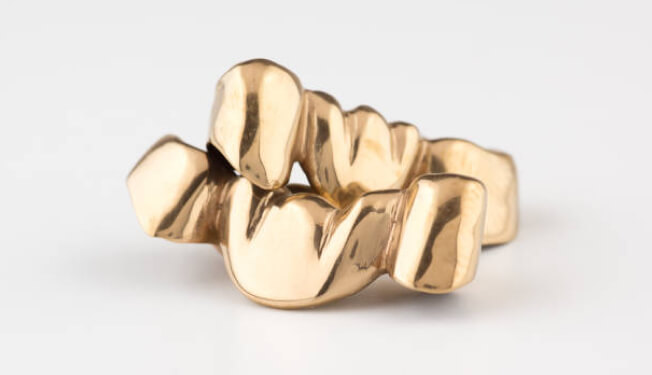
What Are The Alternative Treatments If I Do Not Choose A Gold Dental Bridge?
While a gold dental bridge offers unique advantages, it’s important to explore alternative treatments to ensure you make an informed decision that suits your individual needs and preferences for replacing missing teeth. Here are some alternative treatments to consider:
- Maryland Bridge: Also known as a resin-bonded bridge, this option involves attaching replacement teeth to adjacent teeth with metal or porcelain wings. It’s a conservative choice that requires minimal alteration of surrounding teeth.
- Cantilever Bridge: Similar to a traditional bridge, the cantilever bridge uses an adjacent tooth as an anchor. However, it’s designed for situations where only one adjacent tooth is available for support.
- Zirconia Bridge: Zirconia is a strong and aesthetically pleasing material that can be used for dental bridges. It offers durability and a natural appearance, making it a popular choice among patients.
- Lithium Disilicate Bridge: This type of bridge is made from a glass-ceramic material known for its strength and translucency. It can blend seamlessly with natural teeth, providing both durability and aesthetics.
- Porcelain Fused to Metal Bridge: This bridge combines the strength of a metal framework with the natural appearance of porcelain. It’s a versatile option that offers both functionality and aesthetics.
- Dental Implant: A dental implant involves surgically placing a titanium post into the jawbone to serve as a replacement root. A crown is then attached to the implant, providing a sturdy and long-lasting solution.
- Removable Partial Dentures: If you’re seeking a removable option, partial dentures might be suitable. These dentures are custom-made to fit your mouth and can replace one or more missing teeth. They are held in place by clasps that attach to existing teeth.
- No Treatment: While not a recommended solution, choosing to do nothing about a missing tooth can lead to various oral health issues. Adjacent teeth might shift, bite alignment can be compromised, and bone loss may occur over time.
Each alternative treatment comes with its own set of benefits and considerations. Factors such as cost, durability, aesthetics, and your overall oral health will influence which option is the best fit for you. Consulting with your dentist is important to receive personalized recommendations based on your unique situation. If you have further questions about Gold Dental Bridges, please contact us.
Cost of Dental Bridge
Dental Bridges rely on retainers (natural teeth) to support pontics (false floating teeth where a tooth is missing). Therefore, the price of a dental bridge will depend on the number of pontics and retainers. A 3-unit bridge, for example, would cost $1207+538+1207 plus dental lab fee (approximately $800), which is equal to $3752. The codes relevant to dental bridges in the Ontario Dental Association’s Suggested Fee Guide appear as follows:
Pontics, Porcelain/Ceramic/Polymer Glass
- 62501 – Pontics, Porcelain/Ceramic/Polymer Glass Fused to Metal: $538 + Dental Lab Fee
Retainers, Porcelain/Ceramic/Polymer Glass
- 67201 – Retainer, Porcelain/Ceramic/Polymer Glass: $1207 + Dental Lab Fee
Other factors that could affect the cost of dental bridges include local dental association fee guides, dental bridge materials, qualifications of the dentist or prosthodontist, dental laboratory fees, and whether you have dental insurance coverage.
The Ontario Dental Association’s Suggested Fee Guide is a proposed fee structure that dentists in Ontario may or may not follow. Please consult with your dentist about fees before going ahead with treatment.
Dental bridges are sometimes considered a supplementary service by dental insurance plans and may or may not be covered by your dental insurance. Be sure to find out from your dental insurance plan provider how much you are eligible for before going ahead with dental treatment. Your dentist can help you submit an predetermination to your dental insurance.
For patients without dental insurance, Atlas Dental is pleased to offer dental financing through Dentalcard. Affordable payment plans start at 7.95% for terms of 6 months to 6 years. To learn more about Dentalcard dental treatment financing, follow this link.
What Are The Steps In The Gold Dental Bridge Procedure?
The process of getting a Gold Dental Bridge is a well-coordinated sequence of steps designed to ensure a seamless and successful outcome. Here’s an overview of the typical procedure:
- Initial Consultation: The journey begins with a comprehensive consultation with your dentist. During this appointment, your dentist will assess your oral health, discuss your goals and preferences, and determine whether a gold dental bridge is the best option for you.
- Treatment Planning: If a gold dental bridge is deemed appropriate, your dentist will develop a personalized treatment plan. This plan includes considerations such as the number of missing teeth, the condition of adjacent teeth, and any necessary preparations. Please review these dental bridge pre-visit instructions before your appointment.
- Tooth Preparation: In preparation for the bridge placement, the adjacent teeth that will serve as anchors for the bridge will be prepared. A small portion of enamel will be removed to create space for the dental crowns.
- Impressions: Accurate impressions of your prepared teeth are taken using dental putty or digital scanning technology. These impressions serve as the basis for crafting the custom gold dental bridge that fits seamlessly into your mouth.
- Temporary Bridge: While your permanent bridge is being fabricated, a temporary bridge may be placed to protect your prepared teeth and ensure you can still chew and speak comfortably.
- Bridge Fabrication: Skilled dental technicians will use the impressions to create a custom gold dental bridge that matches your bite and mouth structure. The gold alloy will be precisely molded and shaped to fit your needs.
- Fitting and Adjustment: Once your permanent bridge is ready, your dentist will remove the temporary bridge and fit the new bridge onto your prepared teeth. They will ensure the fit is comfortable and make any necessary adjustments.
- Cementation: Once the fit is perfected, the dental bridge will be permanently cemented onto the prepared teeth. Your dentist will make sure the bridge is securely in place and that your bite is aligned properly.
- Final Adjustments: After the bridge is securely in place, your dentist will make any final adjustments to ensure your bite feels natural and comfortable.
- Aftercare and Maintenance: Your dentist will provide you with dental bridge post-insert instructions on how to care for your gold dental bridge. Proper oral hygiene practices, regular dental check-ups, and preventive care are essential to prolonging the lifespan of your restoration.
By following these steps and collaborating closely with your dentist, you can expect to achieve a restored smile that enhances both your appearance and your overall quality of life. If you have further questions about Gold Dental Bridges, please contact us.
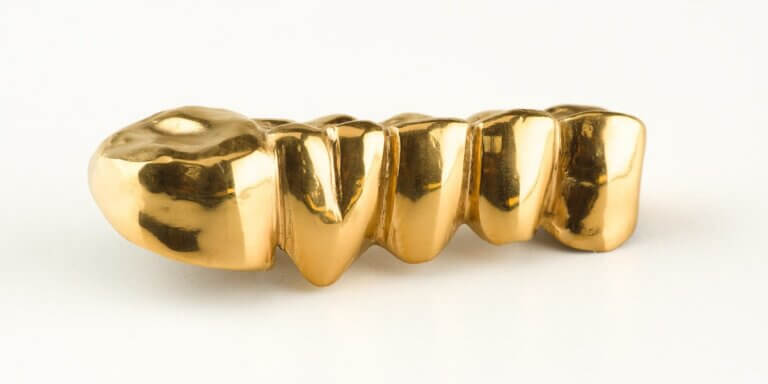
Can I Have A Gold Dental Bridge If I Am Pregnant?
Pregnancy is a time of heightened health considerations, and dental care is no exception. Many dental procedures and treatments are generally safe during pregnancy, but specific factors need to be taken into account to ensure the well-being of both the expectant mother and the developing baby. When it comes to considering a gold dental bridge during pregnancy, there are important points to consider:
- Consultation with Healthcare Providers: If you’re pregnant and considering a gold dental bridge, it’s crucial to communicate with both your dentist and your obstetrician. These healthcare professionals can collaborate to assess your individual situation, taking into account your oral health needs, the stage of your pregnancy, and any potential risks.
- Timing: Depending on the stage of your pregnancy, your dentist and obstetrician will determine the most suitable timing for any dental procedure. Typically, the second trimester is considered the safest period for elective dental treatments, as any potential risks to the developing baby are minimized.
- Anesthesia and Medications: The use of anesthesia and medications should be discussed with your healthcare providers. Local anesthesia is often considered safe during pregnancy, but it’s important to ensure that any medications used are approved for use during pregnancy.
- X-Ray Radiation: Dental X-rays may be necessary during the dental bridge procedure. However, if you’re pregnant, the use of X-rays should be minimized and carried out with proper shielding to protect both you and your baby from unnecessary radiation exposure.
- Stress and Comfort: Pregnancy can bring about increased sensitivity, discomfort, and stress. Your dental team will take these factors into consideration and make every effort to ensure your comfort during the procedure.
- Overall Health: Your general health, including any pregnancy-related complications, will be considered when determining the appropriateness of a gold dental bridge during pregnancy.
Ultimately, the decision to have a gold dental bridge during pregnancy will be made based on careful consideration of your health, the specific circumstances, and the guidance of your healthcare provider and dentist. Open communication between all parties involved is crucial to ensure the best possible outcome for both your dental health and the health of your baby. If you have further questions about Gold Dental Bridges, please contact us.
How Long Does A Gold Dental Bridge Last?
On average, a well-maintained gold dental bridge can last anywhere from 10 to 15 years, and even longer in some cases. The longevity can vary based on individual factors and the care you provide for your oral health.
- Material Quality: The quality of the gold alloy and other materials used in the bridge’s construction plays a significant role in its longevity. High-quality materials crafted by skilled dental technicians tend to result in bridges that withstand the test of time.
- Oral Hygiene: Proper oral hygiene practices are essential for maintaining the health of your natural teeth as well as any dental restorations, including gold dental bridges. Regular brushing, flossing, and using antimicrobial mouthwash can help prevent decay, gum disease, and other issues that could affect the lifespan of the bridge.
- Bite Alignment: A well-fitted gold dental bridge that aligns properly with your bite reduces the risk of excessive wear and tear. Incorrect bite alignment can lead to uneven forces that impact the bridge’s durability.
- Bite and Grinding: If you have a habit of grinding your teeth (bruxism) or if your bite is misaligned, it can put extra stress on the bridge and its supporting teeth, potentially shortening its lifespan.
- Dental Check-Ups: Regular dental check-ups allow your dentist to monitor the condition of your gold dental bridge and identify any potential issues early. Catching and addressing problems promptly can extend the lifespan of the bridge.
- Maintenance: Following your dentist’s recommendations for maintenance and care can significantly prolong the lifespan of your gold dental bridge. This includes avoiding chewing on hard objects, refraining from biting into very sticky foods, and using a nightguard if you have a habit of grinding your teeth.
- Lifestyle Factors: Lifestyle choices, such as smoking or excessive consumption of staining substances like coffee and tea, can impact the appearance and structural integrity of your dental bridge.
Regular dental visits are essential for evaluating the condition of the bridge and making any necessary adjustments or repairs to ensure its optimal performance. If you have further questions about Gold Dental Bridges, please contact us.
What Are Common Problems with A Gold Dental Bridge?
While gold dental bridges are renowned for their durability and longevity, like any dental restoration, they can experience certain issues over time. Regular care, maintenance, and prompt attention to problems can help address these concerns and extend the lifespan of your bridge. Here are some common problems that individuals might encounter with a gold dental bridge:
- Tooth Decay: Even though the bridge itself doesn’t decay, the teeth supporting the bridge can develop cavities if oral hygiene is neglected. Regular brushing, flossing, and dental check-ups are essential to prevent decay in the natural teeth.
- Gum Disease: Inadequate oral hygiene can also lead to gum disease around the bridge area. Gum inflammation and infection can affect the bridge’s stability and long term survival.
- Tooth Sensitivity: Some patients may experience tooth sensitivity after getting a gold dental bridge. Sensitivity can occur due to changes in tooth structure during the bridge preparation process.
- Loose Bridge: If the bridge becomes loose, it might need to be re-cemented. A loose bridge can create discomfort and impact its functionality.
- Wear and Tear: Over time, the bridge might experience normal wear and tear due to biting and chewing. While gold is durable, it’s not immune to wear, and any excessive or uneven forces could lead to damage.
- Aesthetic Changes: While some individuals appreciate the unique appearance of gold dental bridges, others might be concerned about the color contrast between the bridge and natural teeth. Over time, the color of the gold bridge might stand out more noticeably as natural teeth age or change in shade.
- Bruxism Impact: Individuals who grind or clench their teeth (bruxism) can put extra stress on the dental bridge, potentially leading to damage or failure over time. A night guard can help protect the bridge if you have this habit.
Regular dental check-ups are essential for identifying and addressing these problems early on. By promptly addressing any issues and following your dentist’s recommendations for care and maintenance, you can ensure that your gold dental bridge continues to serve you well for years to come. If you have further questions about Gold Dental Bridges, please contact us.
We also think you’ll like…
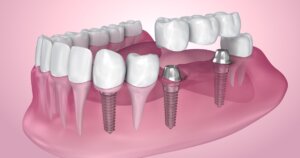
Endosteal Dental Implant
Endosteal Dental Implant What Is An Endosteal Dental Implant? Endosteal Dental Implants stand as a revolutionary solution for restoring smiles and dental functionality. These implants
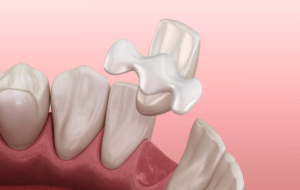
Maryland Dental Bridge
Maryland Dental Bridge What Is A Maryland Dental Bridge? A Maryland Dental Bridge, also known as a resin-bonded fixed partial denture, is a specialized dental
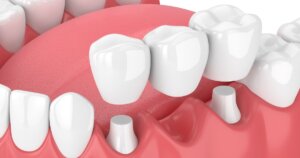
Dental Bridge Recementation
Dental Bridge Recementation What Is Dental Bridge Recementation? For individuals with missing teeth, Dental Bridges provide a functional and aesthetic solution, restoring the ability to
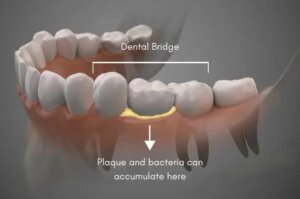
Cavity Under A Bridge
A Cavity Under A Bridge What Is A Cavity Under A Bridge? Dental bridges are a popular tooth replacement option for those who have lost
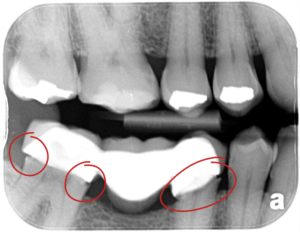
Dental Bridge Open Margin
Dental Bridge Open Margin What Is A Dental Bridge Open Margin? A Dental Bridge is a prosthetic dental appliance that is used to replace one

Dental Implant Bridge
Dental Implant Bridge What Is A Dental Implant Bridge? A dental implant bridge is a prosthetic device used to replace one or more missing teeth

